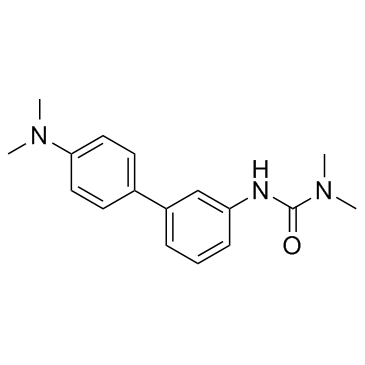| Description |
Atglistatin is a selective adipose triglyceride lipase (ATGL) inhibitor with IC50 of 0.7 μM for lipolysis in vitro.
|
| Related Catalog |
|
| Target |
IC50: 0.7 μM (ATGL)[1]
|
| In Vitro |
Atglistatin inhibits Triacylglycerol (TG) hydrolase activity of wild-type white adipose tissue (WAT) in a dose-dependent manner up to 78% at the highest concentration. In comparison to wild-type preparations, TG hydrolase activity in WAT lysates from ATGL-ko animals is reduced by approximately 70% and Atglistatin had only a moderate effect on the residual activity. The combined use of Atglistatin and the hormone-sensitive lipase (HSL) inhibitor Hi 76-0079 leads to an almost complete inhibition (-95%) of TG hydrolase activity of WAT which implicates that most of the non-ATGL activity can be ascribed to HSL[1].
|
| In Vivo |
Animals receive Atglistatin dissolved in olive oil by oral gavage. After application, blood and tissues are collected for determination of plasma parameters, tissue Triacylglycerol (TG) levels, and inhibitor concentrations. Time-course experiments revealed that the lipolytic parameters fatty acids (FA) and glycerol are reduced 4 and 8 hours after application and returned to normal after 12 hours. Eight hours after treatment, a dose-dependent decrease is observed in FA and glycerol levels up to 50% and 62%, respectively. Atglistatin also caused a strong reduction in plasma TG levels (-43%) while blood glucose, total cholesterol, ketone bodies, and insulin levels do not significantly change. Dose and time-dependent inhibition of lipolysis is also observed in response to intraperitoneal injection of Atglistatin[1].
|
| Cell Assay |
For MTT-based in vitro viability assays, cells are seeded at an initial density of 1×104 cells per well in 96-well plates and cultured under standard conditions for 24 hours. The next day, cells are pretreated with different concentrations of Atglistatin dissolved in DMSO or Cisplatin dissolved in dimethylformamide (DMF) as positive control for two hours. Medium is replaced by an identical fresh medium and incubated again for the indicated time-points. Thereafter cells are incubated for 3 hours with 100 μL Thiazolyl Blue Tetrazolium Bromide (MTT). The resulting violet formazan crystals are dissolved by adding 100 μL of MTT solubilization solution (0.1% NP-40, 4 mM HCl and anhydrous isopropanol). After complete dissolution of the formazan product, absorbance is measured at 595 nm using 690 nm as reference wavelength[1].
|
| Animal Admin |
Mice[1] Mice (C57Bl/6J) are used. Atglistatin is administrated orally by gavage in olive oil (200 μL) or by IP injection. For IP administration, we generated Atglistatin hydrochloride by the addition of 25 % HCl resulting in a water soluble compound. For intraperitoneal injection the inhibitor is dried, excess HCl is buffered with Tris base, and Atglistatin is dissolved in PBS containing 0.25 % Cremophor EL (pH 7.1). Atglistatin is administered orally by gavage in olive oil (1.4 mg/mouse). After 8 h tissues are collected and extracted twice using Folch procedure. Combined organic phases are concentrated, reconstituted in 500 μL chloroform and ssubjected to solid phase extraction (SPE). For SPE samples are loaded onto silica columns washed twice with 2 mL of chloroform and Atglistatin is eluted using 3 mL chloroform/methanol (99/1, v/v). Eluted samples are concentrated, dissolved in n-propanol/chloroform/methanol (8/1.3/0.6, v/v/v) and analyzed by UPLC/MS (m/z 284, MH+; SYNAPT G1 qTOF HD mass spectrometer, Waters).
|
| References |
[1]. Mayer N, et al. Development of small-molecule inhibitors targeting adipose triglyceride lipase. (2013) Nat Chem Biol. 9(12):785-7.
|
